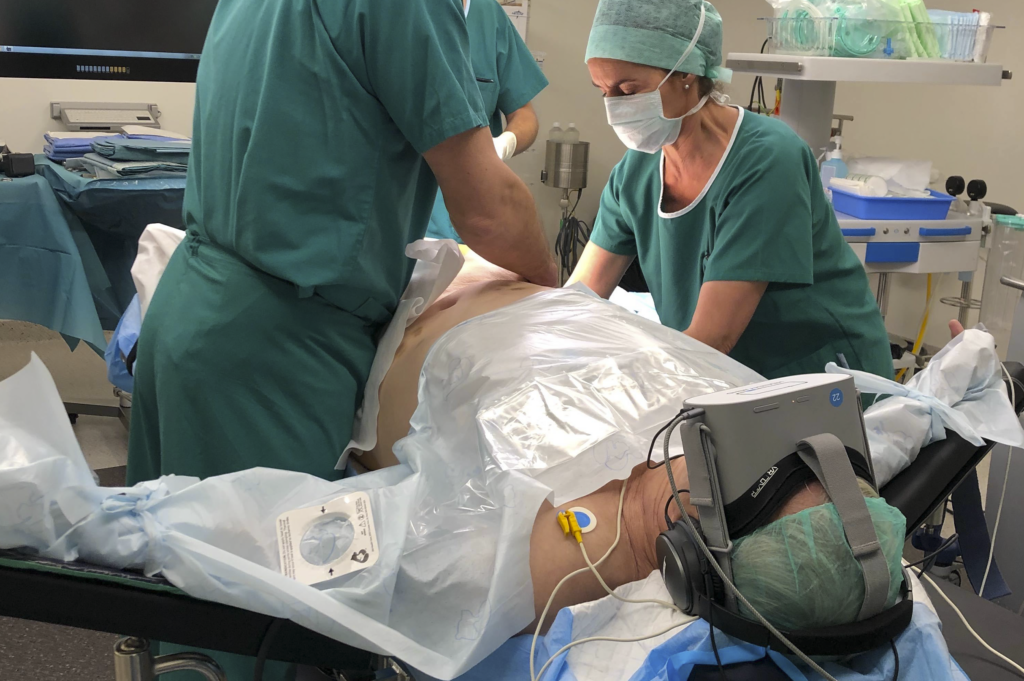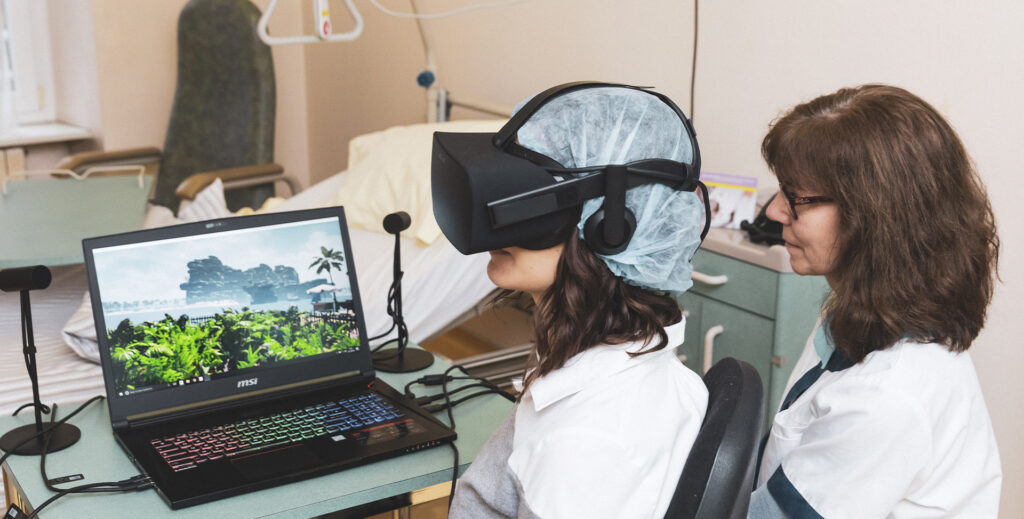
According to Inserm (National Institute of Health and Medical Research), pain is the cause of almost 2/3 of all doctor visits. Because of its ubiquity, this is unpleasant sensory and emotional experience is the subject of numerous studies aimed at thwarting its mechanisms. Under non-pharmacological treatmentstherapeutic virtual reality offers an effective answer to this Pain therapy. How does it work? In this article, learn why this revolutionary technology is changing the medical landscape and providing patients with noticeable relief from both conditions chronic and acute pain.
Distracting attention: an effective painkiller
The more we focus on it painful feeling, the more important it becomes. In one Pain catastrophizing studyResearchers identified three main components of this phenomenon: rumination, reinforcement and fainting. As a result, people with negative pain-related thoughts Experience greater emotional stress and higher intensity than others.
How can we help patients put things into perspective and encourage them to relax? To address this issue, numerous scientific studies have focused on the positive role of Be careful in reducing the perception of pain.
The review How do attention and emotions influence pain processing? examined several studies on the role of Attention distraction in pain reduction. It concluded that attention focused on non-painful or pleasant stimuli can influence pain perception.
Another study needed functional magnetic resonance imaging (fMRI) to explore the underlying neural mechanisms Effect of distraction on pain. The results show that when participants’ attention is on a cognitive task that requires high concentrationThe brain regions involved in pain perception are less activated.
Taken together, these results highlight the importance of attention redirection Pain modulation. By focusing attention on distracting stimuli or cognitive tasks, patients can do this reduce their perception of painwithout the addition of medication.
However, how can this process be initiated when the person is in an anxiety-inducing environment such as a hospital or when intrusive thoughts inhibit the activation of this mechanism?

Studies show how virtual reality reduces pain
Therapeutic virtual reality is becoming increasingly popular in healthcare for pain relief, and for good reason. Several scientific studies have been conducted to investigate this analgesic effect of this device.
A study These were young people who had to undergo painful medical procedures after burns. Caregivers noted a Reducing pain and anxiety during treatment through the use of virtual reality. Another study von Hoffman and his team showed that the detour of attention provided by immersion significantly reduced pain in burn patients.
Another experiment Patients who underwent heart surgery were affected. Some were exposed to virtual reality environments during this time postoperative period, while others received standard care. The results showed that patients who used virtual reality a significant pain reduction etc Reducing analgesic absorption.
HAS systematic review Several clinical studies examined the use of virtual reality as Diversion for pain relief. The results of this analysis showed that virtual reality reduced pain in patients with a variety of conditions, including burns, chronic pain and invasive medical procedures.
Finally, another review examined various studies on the use of virtual reality for Pain control. It highlights possible mechanisms by which virtual reality acts on pain, including diverting the patient’s attention from the painful sensation, inducing a state of relaxation, and reducing anxiety.
Taken together, these studies suggest that the use of virtual reality can reduce pain in a wide range of medical contexts. This technology offers promise non-pharmacological approach for pain therapy. Check out ours clinical studies for further demonstrations of the effectiveness of therapeutic virtual reality.

Combination of several pain-relieving active principles in a single device
By combining several relaxing principles designed to capture attention, therapeutic virtual reality provides a coherent, reliable and relevant response to relieve the patient’s pain in a variety of areas Hospital settingslike Marie-Charlotte Desmaizieres, anesthetist and speaker at the Hypnosis Institute at the Saint-Joseph Hospital in Paris, where our “Healthy Mind” medical device is used Colonoscopiesmention, that:
“The effect goes beyond a simple distraction and some people even achieve a very large effect.” deep state of relaxation. Overall, we are able to reduce or even eliminate sedation and reduce the Duration of post-intervention monitoring.”
What complementary techniques make the Healthy Mind device so effective?
1. Medical hypnosis
Medical hypnosis based on one altered state of consciousness This helps the patient to relieve pain. Several mechanisms are involved in achieving this analgesic effect.
Pain is often accompanied by an intense emotional reaction, such as anxiety, fear, or tension. Medical hypnosis helps modify this emotional response by evoking one State of relaxation, calm and well-being. By regulating the negative emotions associated with pain, hypnosis allows the patient to better cope with pain and experience it less intensely.
On the other hand, hypnosis leads to a state of deep relaxation and intense concentration, which serves to divert attention from pain and perceive it differently. Hypnotic suggestions They change the way the brain processes pain signals by affecting their amplitude or filtering them out.
Finally, hypnosis can stimulate the Release of endorphins, natural substances produced by the body to relieve pain. By inducing a hypnotic state it is possible to activate this endogenous mechanisms and increase endorphin secretion, thereby helping to relieve the pain experienced by the patient.
2. Music therapy
Music therapy is a therapeutic approach that uses melodies to treat a variety of health issues, including pain. Notes have the surprising power to divert attention from the pain by providing them pleasant hearing stimulation. By concentrating on the music, patients can reduce their attention to the painful stimulus.
On the other hand, listening to harmonious sounds is stimulating Release of neurotransmitters like dopamine, a molecule linked to pleasure and well-being. This activation of the reward system helps reduce pain And improve patients’ mood.
In this way, relaxing music helps reduce stress and anxiety that is often associated with pain. Music therapy helps by promoting a state of relaxation Relieve muscle tension.
Additionally, music therapy can stimulate the release of endorphins, the body’s natural painkillers, leading to a reduction in pain levels.

3. Cardiac consistency
Cardiac coherence is a technique that aims to do this regulate the heart rate by controlling breathing. The practice involves slow, deep and regular breathing that promotes Activation of the parasympathetic nervous system. This system is responsible for the body’s relaxation response. This reduces stress, anxiety and muscle tension that accompany pain.
By promoting parasympathetic dominance, cardiac coherence modulates pain-related physiological reactionssuch as increased heart rate and increased blood pressure.
The practice of cardiac coherence is increasing Heart rate variability, i.e. the variations between successive heartbeat intervals. This process is associated with good health and a better ability to cope with stress. As the pain catastrophizing study mentioned above shows, this relaxation contributes to better pain management.
thanks to him practical, ergonomic designThe Healthy Mind solution can be adapted to different practices and patients, ensuring a high-quality, immersive experience. For more information about our device or to test the equipment, please contact us Contact our team.
Sources :
- Villemure, C. & Bushnell, M.C. (2002). Cognitive pain modulation: How do attention and emotion influence pain processing? Bread, 95(3), 195-199.
- Sullivan, M. J. L., Bishop, S. R. & Pivik, J. (1995). The Pain Catastrophizing Scale: Development and Validation. Psychological assessment, 7(4), 524-532.
- Bantick SJ, Wise RG, Ploghaus A, Clare S, Smith SM, Tracey I. Mapping how attention modulates pain in humans using functional MRI. Brain. 2002 Feb;125(Pt 2):310-9. doi:10.1093/brain/awf022. PMID: 11844731.
- Belinda Kipping, Sylvia Rodger, Kate Miller, Roy M. Kimble. Virtual Reality for Acute Pain Relief in Adolescents Undergoing Burn Care: A Prospective, Randomized, Controlled Trial, November 17, 2011.
- Hoffman HG, Patterson DR, Carrougher GJ, Sharar SR. Effectiveness of multi-treatment virtual reality-based pain control. Clin J Pain. 2001 Sep;17(3):229-35. doi:10.1097/00002508-200109000-00007. PMID: 11587113.
- Mosso-Vázquez JL, Gao K, Wiederhold BK, Wiederhold MD. Virtual reality for pain management in cardiac surgery. Cyberpsychol Behav Soc Netw. 2014 Jun;17(6):371-8. doi: 10.1089/cyber.2014.0198. PMID: 24892200; PMCID: PMC4043366.
- Malloy KM, milling LS. The effectiveness of virtual reality distraction for pain reduction: a systematic review. Clin Psychol Rev. 2010 Dec;30(8):1011-8. doi: 10.1016/j.cpr.2010.07.001. Epub 2010, July 13th. PMID: 20691523.
- Mahrer NE, Gold JI. The use of virtual reality for pain control: a review. Curr Pain Headache Rep. 2009 Apr;13(2):100-9. doi:10.1007/s11916-009-0019-8. PMID: 19272275.





